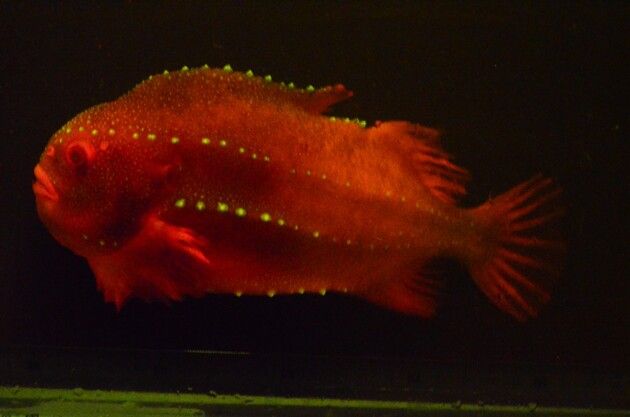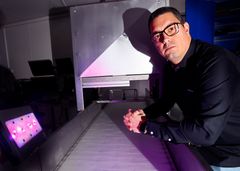Lighting up marine organisms
Animals that are experiencing physical damage or early signs of stress can be visually identified using excitation light that induces fluorescence, research at Nofima shows.

There is an increasing need for methods that can accurately measure stress in aquaculture species, without harming the organism. Hyperspectral imaging of biofluorescence is such a method, as it can potentially measure early signs of stress in both fish and invertebrates.
The fish and invertebrates that exhibit biofluorescence emit lower energy colored light when they are exposed to higher-energy blue light. This strong fluorescence is not visible to the naked eye, but it can be measured with hyperspectral imaging.
“Fish may exhibit welfare traits in ways that are invisible to the human eye, and one of our objectives is to explore new technologies that can reveal this to us in real-time”, says Evan Durland, scientist in aquaculture genetics and project leader.
Welfare indicators are important because animals that experience chronic stress are vulnerable to disease, experience less growth, and ultimately have a higher mortality rate. The current methods used to identify early signs of stress in marine species have certain limitations.
Glowing when stressed
Technology scientists Samuel Ortega and visiting PhD student Thomas Juhasz investigated the applications of using hyperspectral imaging of biofluorescence as a welfare indicator for marine species, particularly lumpfish, red king crab, and green sea urchins.
The scientists found that lumpfish and red king crabs produced stronger fluorescent emissions after exposure to stressors. Put in simple words, the animals glowed more brightly when they experienced acute stress. They also found that sea urchins with broken spines or lesions glow brighter in the areas where they are affected.
The scientist has ideas for how to improve the technology:
“We want to see if we can integrate artificial intelligence (AI) into this method. The AI can analyze the biofluorescence data acquired through hyperspectral imaging, and alert us if it detects any fluorescence changes that may indicate stress in the animals. We believe that this could contribute significantly to the future of welfare measurement during aquaculture operations”, says Samuel Ortega.
The research was funded by the EU Horizon 2020 program through the AquaVitae project, and by Nofima through the Deep Vision project. The research was done by Nofima in collaboration with Marie Curie PhD student Thomas Juhasz in 2022.
Keywords
Contacts
Samuel Ortega SarmientoScientistNofima - Avdeling Sjømatindustri
Tel:+47 77629062Tel:+47 92058823samuel.ortega@nofima.nonofima.com/employee/samuel-ortega-sarmiento/Evan DurlandScientistNofima, Avdeling Avl og genetikk
Tel:+47 64970174Tel:+47 92251745evan.durland@nofima.nonofima.com/employee/evan-durland/Reidun Lilleholt Kraugerud
Tel:48197382reidun.lilleholt@nofima.noImages

Links
About Nofima
The Norwegian food research institute Nofima provides research based knowledge and innovations for actors in all parts of the food systems.

Subscribe to releases from Nofima
Subscribe to all the latest releases from Nofima by registering your e-mail address below. You can unsubscribe at any time.
Latest releases from Nofima
Three months shorter production time11.12.2025 07:00:00 CET | Press release
Selective breeding is a powerful tool to enhance desirable traits in fish and livestock - a fact well established in the industry. Now Manila clam has its own dedicated breeding programme.
Tre måneder kortere produksjonstid11.12.2025 07:00:00 CET | Pressemelding
At avl er et kraftfullt verktøy for å få fremgang i egenskaper man ønsker hos fisk og dyr, er kjent. Nå har teppeskjell fått sitt eget avlsprogram.
Potential for land based red algae25.11.2025 10:39:15 CET | Press release
How could Norway produce more food, utilise high nutrient levels in discharge water and create new businesses?
Potensiale for landbasert rødalge25.11.2025 07:00:00 CET | Pressemelding
Hvordan kan Norge produsere mer mat, rense utslippsvann og skape nye arbeidsplasser?
Norsk sjømatnæring: Nå er ringvirkningene større enn kjernevirksomheten13.11.2025 14:00:00 CET | Pressemelding
Ringvirkningene er nå større enn kjernevirksomheten i sjømatnæringen. Verdiskapingen i sjømatnæringens kjernevirksomhet utgjorde 69 milliarder kroner i 2024, mens ringvirkningene var nesten 70 milliarder.
In our pressroom you can read all our latest releases, find our press contacts, images, documents and other relevant information about us.
Visit our pressroom